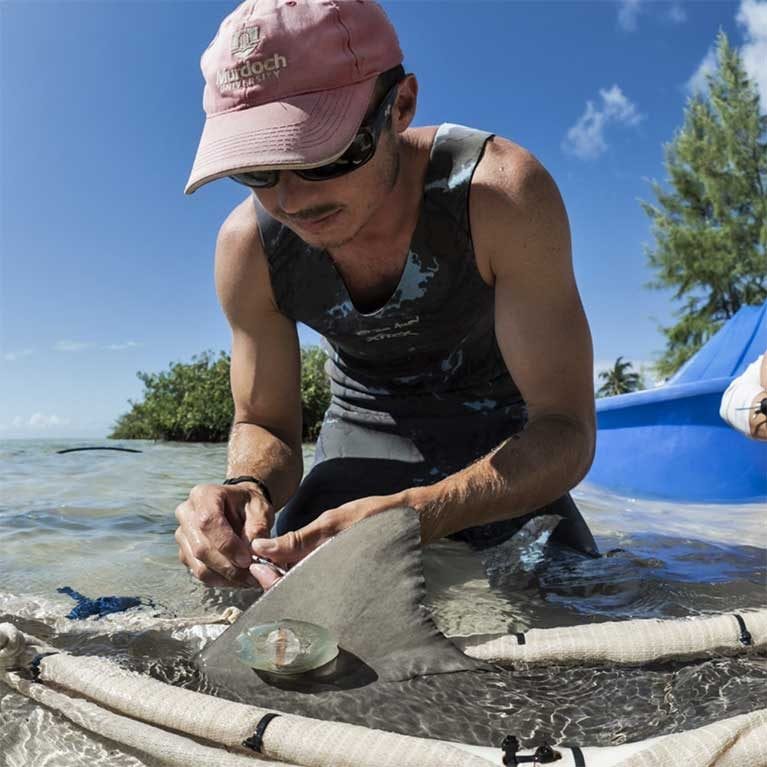Home on the Lemon Shark Range
Does body size influence how much energy a shark needs? Evan is investigating how this is linked to the home range size of lemon sharks, and how they use their habitat.
I am often asked, ‘What made you interested in sharks?’ but I have never been able to nail down a specific time or event that sparked the obsession. As far back as I can remember, and as all of my childhood family stories go, there was never a time when I was not infatuated with sharks and dreaming of becoming a marine biologist.
However, growing up in landlocked Pennsylvania, USA, I had little contact with sharks outside television and books. I made up for it by roaming local creeks and ponds and keeping home aquaria to get my fill of time...


Home range scaling in lemon sharks (Negaprion brevirostris) through ontogeny: tests of bioenergetics mechanisms.
The aim of this project is to determine how body size influences energetic needs of lemon sharks (Negaprion brevirostris) and how these changes in energetics govern home range size and behavioural habitat use.
Marine protected area (MPA) design is guided by the size of animal home ranges or by the habitat requirements of a species, among other factors. Home ranges are commonly estimated using utilization distributions, which assume that the more time an animal spends in a habitat, the more important that habitat must be. However, this assumption fails to account for the fact that animals spend relatively little time foraging, mating, and evading predators, compared to time spent resting. Thus, current estimates incorrectly calculate the importance of various habitats. This project will develop more informative estimations of shark home range use by incorporating data on individual energetic requirements and habitat-specific behavioural patterns, as well as data on habitat and resource characteristics. By understanding which mechanisms govern shark home range use, we will be able to design more effective MPAs and management techniques.
Space use is a fundamental aspect of animal ecology. Understanding the mechanisms that govern space use has important implications for resource acquisition, species’ interactions, and human-wildlife interactions. The area regularly ‘traversed by an individual in its normal activities of foraging, mating, [resting,] and caring for young’, defined as home range, is influenced by physiological and environmental mechanisms, which affect energy needs and distribution of food resources, respectively. Substantial research has examined variation in home range size between species, most notably in terrestrial mammals and birds. However, we still don’t know if the mechanisms that govern mammalian and bird home ranges apply to a wider diversity of vertebrates.
Body size is the principal determinant of home range size in animals due to its direct relationship with energetics. In theory, an animal’s home range must be large enough to encompass the resources required to meet their energetic needs, and given the direct scaling relationship between body mass and metabolic rate, it is expected that home range size should increase with body size at the same rate as metabolic rate. Early work proposed that home range size increased with body mass exponentially at a rate of 0.75. However, empirical studies have demonstrated that the relationship is not straightforward, finding home range increasing with an exponent between 0.5 and 1.08. This discrepancy is due to the fact that the relationship between energetics and space use has largely been speculative, with no research directly testing it.
Sharks present an ideal study species to study the relationship between body size, energetics and home range since they demonstrate large changes in body size over their lifetime, however, relatively little is known about sharks’ energetics [7]. While, previous research has provided a general insight into elasmobranch energetics, few studies have been able to bridge the gap between laboratory and fieldbased estimates. Metabolic rate of smaller sharks can be studied in captivity using respirometry, but their energy use and behaviours have not been tracked in the wild due to the large size of tagging packages. Conversely, while large sharks can be tracked in the wild, extrapolating laboratory estimates of energy expenditure to larger sharks in the field remains problematic, requiring mass-corrected estimates of metabolic rate and cost of transport. Hence, there is a clear need to couple laboratory experiments with field-based observations to better understand elasmobranch energetics and how they contribute to their ecology.
Advances in acceleration data loggers (ADLs) present a tool well suited for the task of coupling laboratory and field based studies. ADLs measure fine scale body movements at high sampling rates, which have been successfully used to decipher specific behavioural patterns, such as foraging and mating, and have been used to calculate energy expenditure in wild animals [8, 9]. Additionally, the small size of ADLs, compared to other biologging tags, allows them to be attached to smaller bodied animals without influencing their behaviours. For example, ADLs have now been used to decipher behaviour and movements of jellyfish, sharks, pinnipeds, cormorants, and other marine organisms. This project proposes to use ADLs to determine how metabolic rate scales with body size in lemon sharks (Negaprion brevirostris), and by combining this knowledge with field observations of individual movement, behaviours and habitat quality, we will determine how body size associated energetic changes predict specific home range size and habitat requirements.
- The first objective will be to determine the thermal and body size dependence of energetic expenditure in sharks, and to establish a predictive equation that can be used to calculate field metabolic rates, when activity, temperature, and body size are known.
- Given that different behaviours have different energetic costs, it is expected that habitats used for different behaviours should scale differently. Our second aim is to identify how behavioural and thermal habitat use changes with body size, the associated energetic gains/costs, and how use of these different habitats scale over ontogeny
- The third objective is to determine how energetic constraints influence home range. To determine this, we will combine data on prey species density, prey energy density, competitor density and individual movement data (objective 2) into resource selection functions to compare shark utilization of habitats with varying energy availability.
- To date, home range models have failed to incorporate how energetic demands change with intraspecific differences in body size and behavioural trade-offs. Therefore, we aim to synthesize our data into home range models that incorporate the energetic trade-offs of habitat use and energetic changes as an individual grows.

